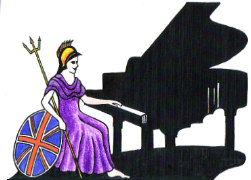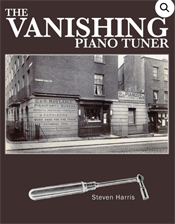Tuning Old Pianos There are many reasons why older pianos go out of tune, and some of them are unavoidable due to the age of the piano, the most common in the UK is central heating drying the piano out.. The most difficult piano for piano tuners to bring back into tune is one that has been neglected for a long period of time. The strings tension drops also because of wear the termination points change this can increase the length of the string thus changing the pitch of individual string in the grope of tree, causing what we call ìfalse beatsî. The pitch of the piano will fall far below 440 Hz (concert pitch). This means that the piano tuner must adjust over 240 strings within an unstable internal environment. The tuner spends time tightening each string in order to raise its pitch. This process takes some time as the tuner must tune each string several times to achieve the required pitch and tension. This is because the adjacent strings will change in response to sudden changes in string tension. To get around this problem, the tuner must first raise all strings to an average degree of tension. After this average level is achieved, the tuner can make minute adjustments to the piano string. It takes time to do this properly, which can be expensive. To avoid a long expensive tuning sessions on an old piano, the piano should be tuned every six months as regular tuning will pay off in the long run.
Tuning New Pianos
What the manufactures say...
Steinway
"We usually recommend our customers at least 2 or 3 tunings per year for a piano getting average use in the home. Ideally 4 tunings spaced through the year to cover the seasonal changes would be best. A new piano settling into a new environment may need more regular tuning for the first year or two. These suggestions only apply to pianos in the average home. Pianos in music schools and teacherís pianos should be tuned more frequently as they receive heavy use. Studio and concert pianos are tuned before every concert or recording."
Yamaha
Adopt a schedule of regular service:
- Why schedule regular service? Having your piano serviced regularly is a lot like taking vitamins. As you regularly take vitamins, you generally feel better and you are able to perform at your peak level. Also, taking vitamins helps you avoid serious illnesses and other health-related problems. The same is true regarding regular service for your piano. Regular service will keep your piano's performance (and your enjoyment) at its peak level. It will also correct "progressive" problems early, before they turn into costly repairs. For these reasons Yamaha strongly recommends that you adopt a schedule of regular service for your piano.
- Tuning and adjustment: Pianos are delicate instruments that need professional attention periodically. Basically there are two types of professional piano care: tuning and adjustment.
- Tuning means correcting the pitch of every note by retightening the strings. Each piano string is normally stretched to a pressure of about 90 kilograms (198pounds). Eventually, though, it will stretch further with use and lose some of its tension, causing the piano to lose its correct pitch. The strings need to be tuned a minimum of twice a year to restore them to their proper tension.
- Adjustment involves the entire piano action, keyboard and pedal movements. Proper adjustment is especially important for grand pianos. Whether the piano will perform properly or not depends how accurately the adjustment is made.
Tuning and adjustment should always be done by an expert. When your piano requires either one, ask your Yamaha dealer or call a specialist piano tuner. Your dealer can also advise you about the interval between adjustments for your piano under the circumstances in which it is used.
-


